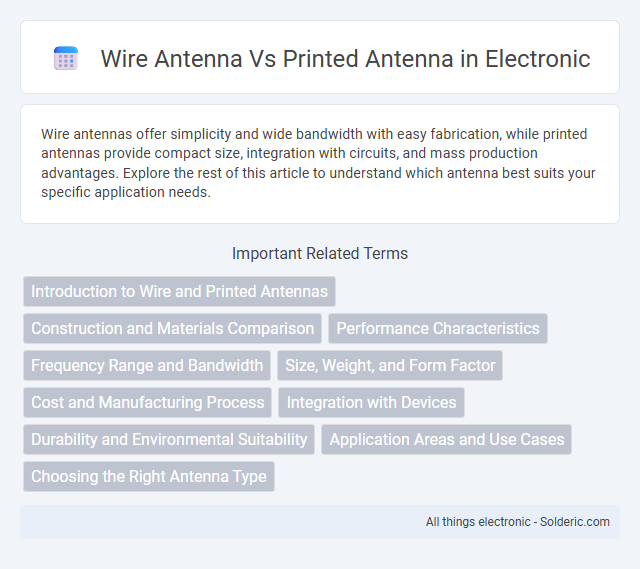Wire antennas offer simplicity and wide bandwidth with easy fabrication, while printed antennas provide compact size, integration with circuits, and mass production advantages. Explore the rest of this article to understand which antenna best suits your specific application needs.
Comparison Table
| Feature | Wire Antenna | Printed Antenna |
|---|---|---|
| Structure | Metal wire or rod | Conductive pattern on PCB |
| Size | Generally larger | Compact and low-profile |
| Manufacturing | Manual or mechanical assembly | Mass-produced via PCB processes |
| Cost | Moderate to high | Cost-effective for large volumes |
| Performance | High gain, wider bandwidth | Good for specific frequency bands |
| Durability | Susceptible to physical damage | Robust, integrated into device |
| Applications | Broadcasting, long-range communication | Mobile devices, IoT, compact systems |
Introduction to Wire and Printed Antennas
Wire antennas use thin conductive wires to transmit and receive radio signals, renowned for their simple construction and wide frequency range. Printed antennas are fabricated on PCB substrates, offering compact size and ease of integration into modern electronic devices. Your choice depends on factors like space constraints, frequency requirements, and application environment.
Construction and Materials Comparison
Wire antennas typically feature simple construction using conductive metal wires such as copper or aluminum, offering flexibility and ease of installation. Printed antennas, manufactured with conductive ink or metal layers on substrates like FR4 or flexible polymers, allow compact designs and integration into devices. Your choice depends on factors like durability, space constraints, and frequency requirements in your application.
Performance Characteristics
Wire antennas generally offer higher efficiency and better bandwidth performance due to their larger physical size and lower conductor losses. Printed antennas, while more compact and lightweight, often exhibit narrower bandwidth and slightly reduced gain because of substrate dielectric losses and limited radiating area. Both types vary in radiation patterns and polarization, but wire antennas typically provide more consistent omnidirectional coverage compared to the directional nature of many printed designs.
Frequency Range and Bandwidth
Wire antennas generally offer a broad frequency range and wide bandwidth due to their physical length and design flexibility, making them suitable for HF to VHF applications. Printed antennas, such as microstrip or patch antennas, typically operate within narrower bandwidths and are optimized for UHF and microwave frequencies, benefiting from compact size and integration with circuits. The choice between wire and printed antennas depends on the required operational frequency and bandwidth, with wire antennas favored for lower frequencies and wider bandwidths, while printed antennas excel in high-frequency, space-constrained environments.
Size, Weight, and Form Factor
Wire antennas typically offer a slimmer profile and lighter weight due to their simple conductive wire construction, making them ideal for minimal form factor applications. Printed antennas integrate conductive traces on a dielectric substrate, which can increase thickness and weight but allow for more compact, planar designs that fit seamlessly into modern devices. Size optimization in wire antennas depends on length and shape, whereas printed antennas leverage precise lithography for miniaturization and flexible geometric configurations.
Cost and Manufacturing Process
Wire antennas typically offer a lower manufacturing cost due to simpler materials and straightforward assembly processes, making them ideal for budget-conscious applications. Printed antennas require more advanced fabrication techniques, such as photolithography or etching on PCB substrates, which increase production complexity and cost. You should consider wire antennas if your project prioritizes cost-efficiency and ease of manufacturing over miniaturization or integration with electronic circuits.
Integration with Devices
Wire antennas offer high flexibility for integration with various devices due to their simple, customizable shapes and ease of installation in complex environments. Printed antennas provide superior integration with modern electronic devices by enabling compact, low-profile designs directly on circuit boards, supporting miniaturization and mass production. The choice between wire and printed antennas depends on device size constraints, manufacturing processes, and specific application requirements.
Durability and Environmental Suitability
Wire antennas typically offer superior durability due to their thicker conductors and robust construction, making them more resistant to environmental factors such as wind, rain, and UV exposure. Printed antennas, often fabricated on thin substrates, are more susceptible to damage from moisture, temperature fluctuations, and mechanical stress, which can reduce their lifespan in harsh environments. Choosing the right antenna depends on your application's environmental conditions and the required longevity.
Application Areas and Use Cases
Wire antennas are commonly used in traditional communication systems, including shortwave radios, amateur radio, and military applications due to their simplicity, wide frequency range, and ease of installation. Printed antennas are prevalent in modern wireless devices such as smartphones, RFID tags, and internet-of-things (IoT) sensors because of their compact size, cost-effectiveness, and compatibility with printed circuit board (PCB) technology. The choice between wire and printed antennas depends on application requirements like frequency range, device form factor, and integration complexity.
Choosing the Right Antenna Type
Choosing the right antenna type depends on the specific application and space constraints; wire antennas offer simple design, low cost, and good performance in open environments, making them ideal for long-range transmissions. Printed antennas, integrated on PCB substrates, provide compact size, ease of mass production, and excellent suitability for modern wireless devices like smartphones and IoT gadgets. Evaluating factors such as frequency range, bandwidth, installation environment, and manufacturing costs guides the optimal selection between wire and printed antennas for effective signal transmission.
wire antenna vs printed antenna Infographic

 solderic.com
solderic.com